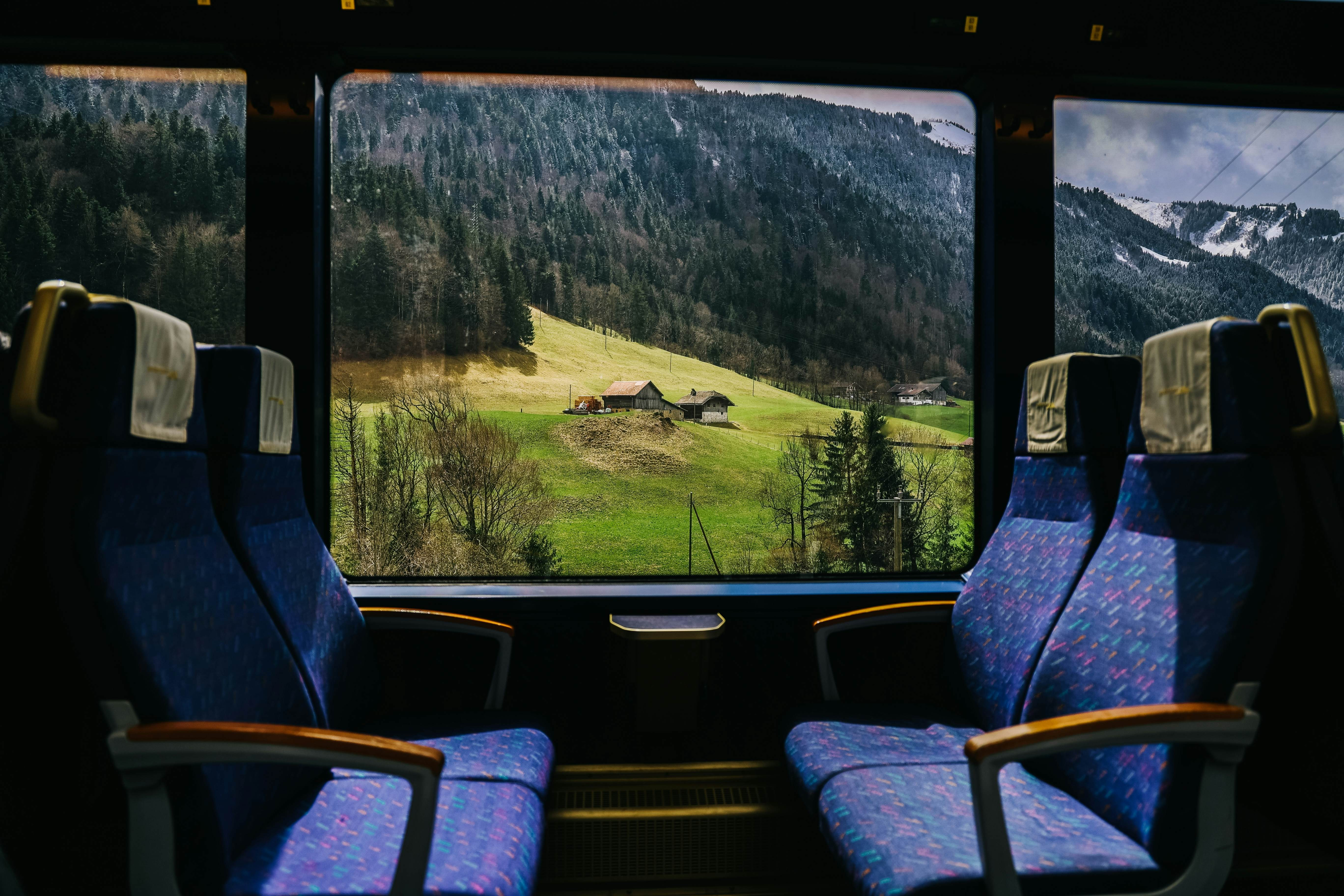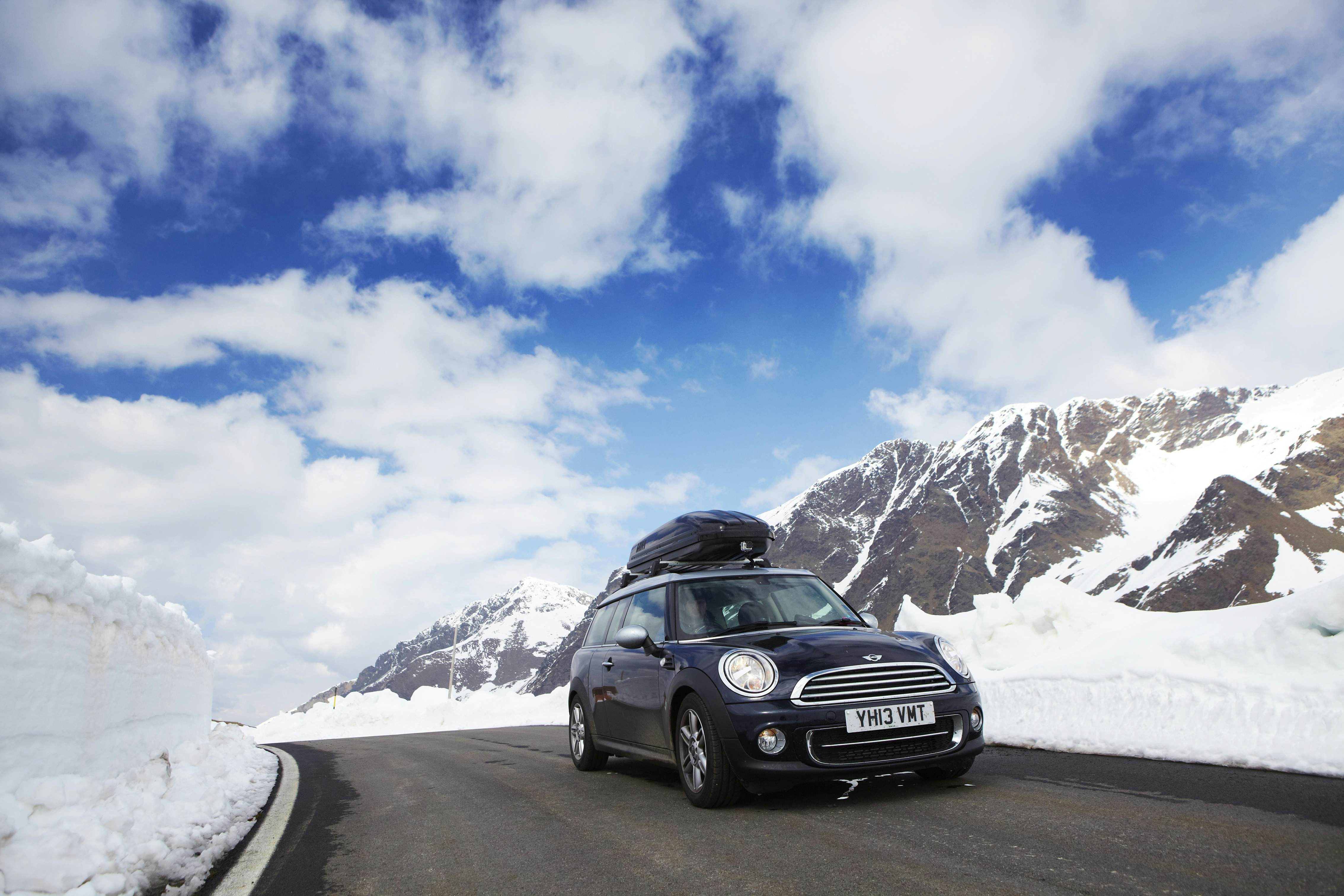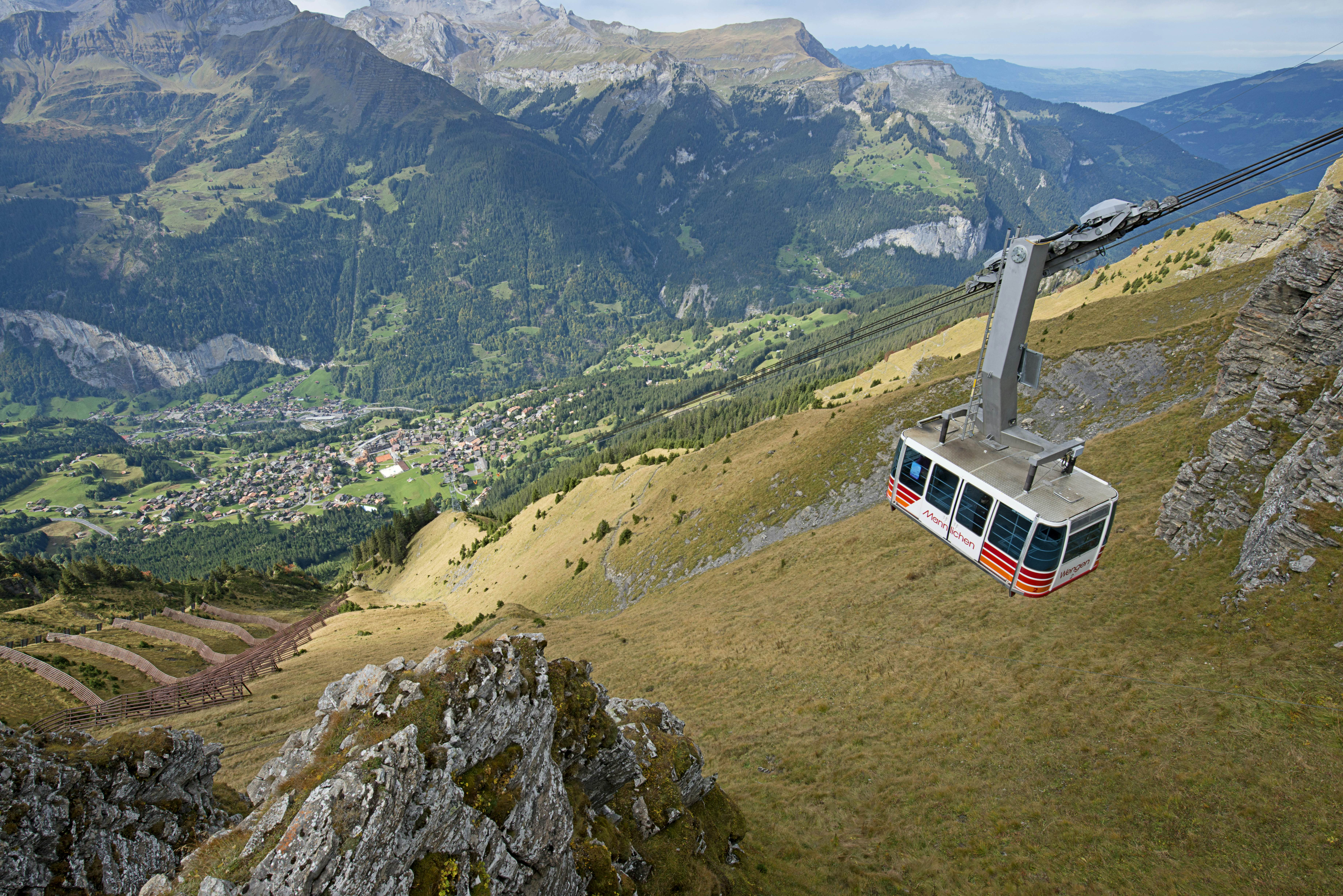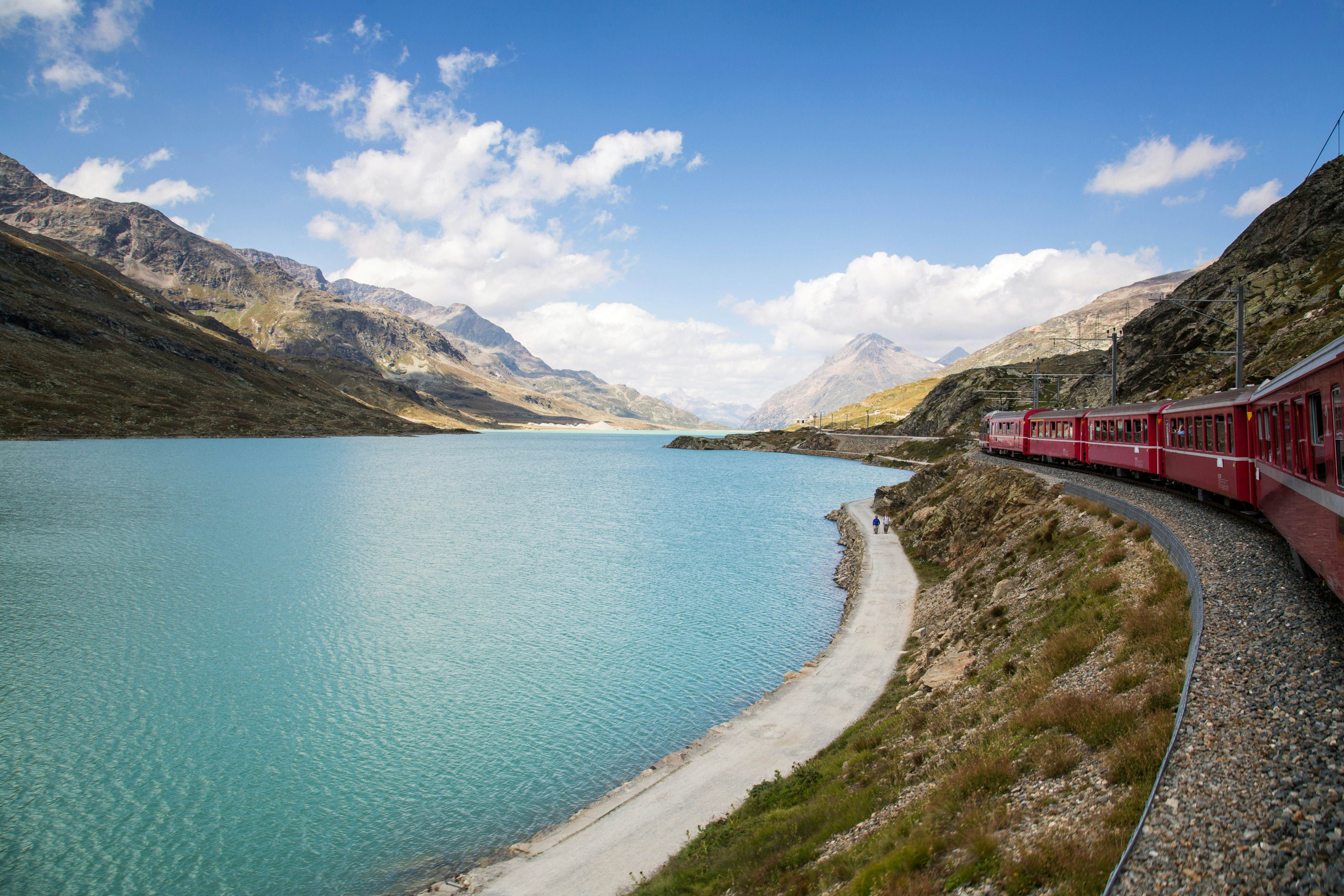Are you dreaming of exploring the breathtaking landscapes of Switzerland? This guide provides a detailed overview of How To Travel Within Switzerland efficiently and sustainably, ensuring you experience the best of this Alpine nation. With SIXT.VN, planning your Swiss adventure is easier than ever, offering seamless travel solutions tailored to your needs. Discover the charm of Switzerland with reliable transportation options, from scenic train rides to picturesque road trips, and create unforgettable memories. Let SIXT.VN be your trusted partner for an exceptional journey.
1. Embrace the Swiss Scenery by Train
The Swiss rail system is renowned for its efficiency, modernity, and commitment to environmental sustainability. Traveling by train in Switzerland provides stunning views and a comfortable experience.
Major cities such as Bern, Geneva, Zurich, and Basel are well-connected by frequent rail services. Tickets can be purchased on the day of travel at stations or via the official Swiss Railways website. Booking “supersaver” tickets in advance often yields significant discounts. According to research from the Swiss Travel Association, in 2023, train travel is the most popular way to get around Switzerland, offering a unique blend of efficiency and scenic beauty.
 Wonderful view of Switzerland with mountain from the window of Golden pass line train, Zweisimmen to Montreux.Admire the views across Switzerland from the train.
Wonderful view of Switzerland with mountain from the window of Golden pass line train, Zweisimmen to Montreux.Admire the views across Switzerland from the train.
1.1. What Are the Benefits of Opting For Train Travel in Switzerland?
Choosing train travel in Switzerland offers several benefits:
- Efficiency: Swiss trains are known for their punctuality and seamless connections.
- Comfort: Modern trains provide comfortable seating and amenities.
- Eco-Friendly: Rail travel is a sustainable transportation option, reducing your carbon footprint.
- Scenic Views: The extensive rail network offers breathtaking views of the Swiss Alps and countryside.
1.2. How Do Panoramic Trains Enhance the Swiss Travel Experience?
Panoramic trains, such as the Glacier Express and Bernina Express, are designed to provide tourists with enhanced views of the Swiss landscape. These trains feature extra-large windows, allowing passengers to fully immerse themselves in the stunning scenery. Reservations are typically required, and tickets are often sold for specific segments of the journey.
However, scheduled services that run on the same routes can be equally enjoyable and more budget-friendly. These trains offer similar views without the premium price tag.
1.3. What Tips Can Help Save Money on Scenic Train Journeys?
To save money on scenic train journeys, consider the following tips:
- Book Supersaver Tickets: Purchase tickets in advance on the Swiss Railways website to take advantage of discounted fares.
- Opt for Regular Services: Choose regularly scheduled trains over panoramic trains for similar views at a lower cost.
- Swiss Travel Pass: Consider purchasing a Swiss Travel Pass for unlimited travel on trains, buses, and boats.
- Travel During Off-Peak Hours: Avoid traveling during peak hours to secure cheaper fares and less crowded trains.
2. Experience a Driving Adventure in Switzerland
Driving in Switzerland allows you to explore the country’s stunning landscapes at your own pace. The well-maintained roads wind through lakes, vineyards, and Alpine passes, offering cinematic views.
The Grand Tour of Switzerland, a 1600km route, connects 12 UNESCO World Heritage Sites, showcasing the best of the Alpine nation. This route is fully accessible by electric car, promoting eco-friendly travel. Car rental companies are available at airports and in cities, with many offering electric vehicle options. According to the Swiss Federal Roads Office, in 2022, over 20% of new car registrations were electric vehicles, reflecting the country’s commitment to sustainable transportation.
 Mini driving on snow lined road in SwitzerlandEnsure you have winter tires when driving on snowy mountain roads in Switzerland.
Mini driving on snow lined road in SwitzerlandEnsure you have winter tires when driving on snowy mountain roads in Switzerland.
2.1. What Are the Advantages of Driving Through Switzerland?
Driving in Switzerland offers several key advantages:
- Flexibility: Explore at your own pace and stop at scenic spots along the way.
- Accessibility: Reach remote areas not easily accessible by public transport.
- Scenic Routes: Enjoy breathtaking views along well-maintained roads.
- Electric Vehicle Infrastructure: Benefit from widespread charging stations for electric cars.
2.2. What Should You Know About the Grand Tour of Switzerland?
The Grand Tour of Switzerland is an iconic road trip that highlights the country’s most beautiful regions and UNESCO World Heritage Sites. Key facts about the Grand Tour include:
- Length: 1600 km (994 miles)
- Signage: Efficiently signposted for easy navigation
- Highlights: Links 12 UNESCO World Heritage Sites
- Eco-Friendly: Entirely drivable by electric car
2.3. What Are Some Essential Tips for Driving on Swiss Freeways?
When driving on Swiss freeways, keep these tips in mind:
- Vignette Requirement: A one-time annual charge of Sfr40 is required to use freeways and semi-freeways.
- Purchase Options: The E-vignette is available online or as a sticker at border crossings, gas stations, post offices, and tourist offices.
- Display: The sticker must be displayed on the windshield.
- Winter Conditions: Always check road conditions before driving in the Alps, especially during winter. High passes are typically open from June to October.
3. Discover Remote Mountain Regions by Bus
Switzerland’s bright yellow postal buses, operated by PostBus, offer a unique and scenic way to reach remote mountain regions. The PostBus service is synchronized with train arrivals, with bus stops conveniently located next to railway stations. According to PostBus Switzerland, the service covers over 32,000 km of routes, ensuring even the most remote areas are accessible.
 A cable car dangles high above the Lauterbrunnen Valley in SwitzerlandExplore Switzerland’s highest points via cable car, mountain railway or funicular.
A cable car dangles high above the Lauterbrunnen Valley in SwitzerlandExplore Switzerland’s highest points via cable car, mountain railway or funicular.
3.1. What Makes Postal Buses a Unique Travel Option in Switzerland?
Postal buses offer a unique travel experience due to their:
- Extensive Network: Reach remote mountain regions not accessible by train.
- Synchronization: Timetables are coordinated with train arrivals for seamless transfers.
- Scenic Routes: Enjoy picturesque views along winding mountain roads.
- Affordable Prices: Fares are comparable to train fares, with Swiss national travel passes being valid.
3.2. How Do You Purchase Tickets for Postal Buses?
Tickets for postal buses can be purchased directly from the driver. However, for scenic routes over the Alps, such as the Lugano to St Moritz run, reservations are necessary.
3.3. Are Swiss Travel Passes Valid on Postal Buses?
Yes, Swiss national travel passes are generally valid on postal buses. However, some tourist-oriented Alpine routes may levy a surcharge. It is always a good idea to check in advance to avoid any surprises.
4. Experience Mountain Railways, Cable Cars, and Funiculars
Mountain railways, cable cars, and funiculars provide an exhilarating way to ascend to the highest Alpine peaks. These marvels of engineering offer stunning views and are a highlight of traveling in Switzerland, offering access to spectacular snowy summits and glaciers.
According to Switzerland Tourism, these modes of transport are subject to regular safety checks, ensuring a secure and enjoyable experience. Local money-saving passes are available, often proving cheaper than individual tickets due to the high costs associated with vertical transport.
4.1. What Makes Mountain Railways, Cable Cars, and Funiculars a Must-Try?
These modes of transport offer:
- Spectacular Views: Ascend to snowy summits and glaciers with breathtaking vistas.
- Engineering Marvels: Experience the ingenuity of Swiss engineering.
- Accessibility: Reach high-altitude destinations with ease and safety.
- Unique Experience: Enjoy a thrilling ride through stunning Alpine landscapes.
4.2. What Safety Measures Are in Place for These Modes of Transport?
Safety is a top priority for mountain railways, cable cars, and funiculars:
- Regular Checks: All systems undergo frequent inspections and maintenance.
- Stringent Standards: Swiss engineering adheres to high safety standards.
- Professional Staff: Trained personnel ensure safe operation and passenger comfort.
4.3. What Should You Consider Before Taking a Cable Car?
Before taking a cable car, remember to:
- Check the Last Departure Time: Ensure you know the time of the last cable car down the mountain, especially in winter when it may be as early as 4 pm due to fading light.
- Weather Conditions: Be aware of current weather conditions, as they can affect cable car operations.
- Money-Saving Passes: Look into local money-saving passes to reduce costs.
5. Navigate Switzerland’s Lakes by Boat
Switzerland, despite being landlocked, features passenger boats on its numerous large lakes, operated by Swiss Federal Railways or private companies. National travel passes are valid on these services.
Lakes such as Lake Geneva, Constance, Lucerne, Lugano, Neuchâtel, Biel, Murten, Thun, Brienz, and Zug offer scenic boat routes. Traveling by boat provides a leisurely and delightful way to experience the Swiss landscape. SwitzerlandMobility offers detailed information on regional and national canoe routes for those seeking a more active water adventure.
 A red Bernina Express train travels along a lakeshore in SwitzerlandA Swiss Travel Pass provides unlimited travel plus discounts.
A red Bernina Express train travels along a lakeshore in SwitzerlandA Swiss Travel Pass provides unlimited travel plus discounts.
5.1. Which Lakes Offer Passenger Boat Services in Switzerland?
Passenger boats operate on the following Swiss lakes:
- Lake Geneva
- Lake Constance
- Lake Lucerne
- Lake Lugano
- Lake Neuchâtel
- Lake Biel
- Lake Murten
- Lake Thun
- Lake Brienz
- Lake Zug
5.2. What Benefits Does Boat Travel Provide Compared to Other Transport Methods?
Boat travel offers distinct advantages:
- Scenic Views: Enjoy unparalleled views of the lakes and surrounding landscapes.
- Relaxing Pace: Experience a slower, more leisurely mode of transportation.
- Unique Perspective: See Switzerland from a different angle.
- Accessibility: Access lakeside towns and villages with ease.
5.3. What Options Are Available for Canoe Enthusiasts?
SwitzerlandMobility provides detailed information on regional and national canoe routes, catering to both beginners and experienced paddlers. These routes allow you to explore Switzerland’s lakes and rivers up close.
6. Invest in a Swiss Travel Pass for Cost-Effective Travel
Given the high cost of travel in Switzerland, visitors should consider investing in a Swiss Travel Pass. This pass offers unlimited travel by train (including premium panorama trains), bus, and boat, as well as local public transportation in cities.
Additionally, the pass grants free entry to 500 museums and discounts of up to 50% on mountain excursions. The Swiss Family Card allows children under 16 to travel free of charge when accompanied by at least one parent holding a Swiss Travel System ticket.
6.1. What Are the Key Benefits of the Swiss Travel Pass?
The Swiss Travel Pass provides numerous benefits:
- Unlimited Travel: Enjoy unrestricted travel on trains, buses, and boats.
- Museum Access: Gain free entry to 500 museums across Switzerland.
- Mountain Excursion Discounts: Receive up to 50% off on mountain excursions.
- Local Transportation: Use local public transportation in cities without additional costs.
6.2. How Does the Swiss Family Card Benefit Families Traveling in Switzerland?
The Swiss Family Card allows children under 16 to travel free of charge when accompanied by at least one parent holding a Swiss Travel System ticket, making it an excellent option for families.
6.3. How Can You Determine If a Swiss Travel Pass Is Economical for Your Trip?
To determine if a Swiss Travel Pass is economical, consider:
- Trip Duration: Shorter trips may not warrant the cost of a pass.
- Travel Frequency: If you plan to travel extensively, the pass is likely cost-effective.
- Activities: Factor in the value of free museum entries and discounted mountain excursions.
- Calculate Costs: Compare the cost of individual tickets to the pass price to make an informed decision.
7. Explore Switzerland Up Close by Bicycle
Switzerland is perfectly set up for cyclists, whether you prefer road biking, mountain biking, or a gentle pedal along lakeshores and through vineyards. Many cities offer free or inexpensive bike-rental schemes, and bicycle and e-bike rentals are commonly available at train stations.
Well-signed and highly scenic cycle routes run along rivers and lakeshores, ideal for two-wheel adventures. SwitzerlandMobility provides details on national, regional, and local routes, rental options (including e-bikes), bike-friendly accommodations, guides, and maps.
 Mountain bikers stop for a break at a picturesque lookout over the Swiss Alps, in the Portes du Soleil region.Enjoy cycling routes along rivers and lakeshores.
Mountain bikers stop for a break at a picturesque lookout over the Swiss Alps, in the Portes du Soleil region.Enjoy cycling routes along rivers and lakeshores.
7.1. What Makes Switzerland Ideal for Cycling?
Switzerland is a cyclist’s paradise due to its:
- Scenic Routes: Numerous well-signed routes along rivers, lakes, and through vineyards.
- Rental Availability: Easy access to bike and e-bike rentals at train stations and in cities.
- Infrastructure: Well-maintained paths and bike-friendly accommodations.
- Variety: Options for road biking, mountain biking, and leisurely rides.
7.2. How Can You Transport Your Bike on Swiss Trains?
Bikes can be taken on slower trains and sometimes on InterCity (IC) or EuroCity (EC) trains if there’s room in the luggage carriage. Advance booking is sometimes necessary.
7.3. What Resources Are Available for Planning a Cycling Trip in Switzerland?
SwitzerlandMobility is a valuable resource, offering:
- Route Details: Information on national, regional, and local cycling routes.
- Rental Options: Listings of bike and e-bike rental locations.
- Accommodations: Bike-friendly accommodation options.
- Guides and Maps: Resources for planning and navigating your cycling trip.
8. Utilize Accessible Transportation Options
Switzerland is among the most navigable countries for travelers with physical disabilities. Most train stations have mobile lifts for boarding trains, and city buses are equipped with ramps. The majority of modern hotels offer wheelchair access, although budget accommodations may lack elevators.
Switzerland Tourism provides excellent information on barrier-free travel, including airport arrangements, assisted rail travel, and disabled parking. Procap is an authority on barrier-free travel in Switzerland. The SBB offers helpful pages on accessible travel, including details on tickets, booking assistance, and journey planning.
8.1. What Makes Switzerland Accessible for Travelers With Disabilities?
Switzerland’s accessibility features include:
- Train Stations: Most stations have mobile lifts for boarding trains.
- City Buses: Equipped with ramps for wheelchair access.
- Modern Hotels: Offer wheelchair access.
- Information Resources: Switzerland Tourism and SBB provide detailed information on accessible travel.
8.2. Where Can You Find Information on Barrier-Free Travel in Switzerland?
Valuable resources include:
- Switzerland Tourism: Provides information on airport arrangements, assisted rail travel, and disabled parking.
- Procap: An authority on barrier-free travel in Switzerland.
- SBB: Offers details on tickets, booking assistance, and journey planning for accessible travel.
8.3. What Specific Assistance Does SBB Offer for Travelers With Reduced Mobility?
SBB provides:
- Ticket Information: Details on purchasing tickets for accessible travel.
- Booking Assistance: Help with booking travel arrangements.
- Journey Planning: Assistance in planning accessible routes.
9. What are the top attractions and activities in Switzerland?
Switzerland boasts a plethora of attractions and activities catering to diverse interests. From natural wonders to cultural landmarks, here’s a curated list of must-see destinations and experiences:
9.1. Natural Wonders
The Matterhorn: An iconic pyramidal peak in the Swiss Alps, perfect for hiking, climbing, and photography.
Lake Geneva: One of the largest lakes in Europe, offering boat tours, lakeside walks, and views of the Jet d’Eau fountain.
Rhine Falls: The largest waterfall in Europe, providing spectacular views from various platforms and boat trips.
Swiss National Park: Switzerland’s only national park, offering numerous hiking trails and opportunities to observe wildlife.
Aletsch Glacier: The largest glacier in the Alps, accessible via hiking and cable car, providing breathtaking ice landscapes.
9.2. Cultural Landmarks
Chillon Castle: A medieval fortress on the shores of Lake Geneva, offering historical insights and picturesque views.
Zytglogge: A medieval clock tower in Bern with an astronomical clock, showcasing historical and cultural significance.
Chapel Bridge: A covered wooden bridge in Lucerne adorned with paintings, representing Swiss history and art.
Grossmünster: A Romanesque-style church in Zurich with twin towers, offering panoramic city views from its Karlsturm tower.
FIFA World Football Museum: Located in Zurich, dedicated to the history of football, showcasing exhibits, artifacts, and interactive displays.
9.3. Activities
Hiking in the Swiss Alps: Explore various trails catering to different fitness levels, providing scenic mountain views.
Skiing and Snowboarding: Experience world-class ski resorts like Zermatt, St. Moritz, and Davos, offering groomed slopes and off-piste adventures.
Paragliding: Enjoy tandem paragliding experiences over Interlaken, soaring above lakes and mountains.
Chocolate Tasting: Visit chocolate factories and boutiques to sample and learn about Swiss chocolate making.
Train Journeys: Embark on scenic train routes like the Glacier Express and Bernina Express, providing panoramic views.
10. What essential documents and preparations should I make before traveling to Switzerland?
Before embarking on your Swiss adventure, ensure you have the following documents and preparations in place:
10.1. Essential Documents
Passport: Ensure your passport is valid for at least six months beyond your intended stay in Switzerland.
Visa: Check visa requirements based on your nationality. Many countries have visa-free agreements with Switzerland for tourism stays of up to 90 days.
Travel Insurance: Purchase travel insurance covering medical emergencies, trip cancellations, and lost belongings.
Driver’s License (if renting a car): An international driving permit (IDP) is recommended if your driver’s license is not in a Roman alphabet language.
Swiss Travel Pass or Tickets: Have your Swiss Travel Pass or train/bus tickets readily available for inspection.
10.2. Preparations
Accommodation Bookings: Confirm your hotel, hostel, or Airbnb reservations in advance, especially during peak seasons.
Currency: Switzerland uses the Swiss Franc (CHF). Exchange currency or use credit cards.
Adaptor: Switzerland uses Type C and Type J plugs. Bring a universal adapter if your devices use different plugs.
Weather-Appropriate Clothing: Pack layers as the weather can vary, especially in mountainous regions.
Language: Learn basic German, French, or Italian phrases as Switzerland has multiple official languages.
FAQ: Your Questions About Traveling Within Switzerland Answered
1. What is the best way to travel around Switzerland?
The best way to travel around Switzerland depends on your priorities. For efficiency and scenic views, trains are ideal. For flexibility and access to remote areas, driving is a great option.
2. How much does it cost to travel in Switzerland?
Switzerland is generally an expensive country. Budget travelers can expect to spend around CHF 100-150 per day, while a mid-range budget would be CHF 200-300 per day.
3. Is it easy to get around Switzerland without a car?
Yes, Switzerland has an excellent public transportation system, making it easy to get around without a car. Trains, buses, and boats connect most towns and cities.
4. Can I use Euros in Switzerland?
While some businesses may accept Euros, the official currency is the Swiss Franc (CHF). It’s advisable to use CHF for most transactions.
5. What is the Swiss Travel Pass and is it worth it?
The Swiss Travel Pass offers unlimited travel on trains, buses, and boats, as well as free entry to many museums. It’s worth it if you plan to travel extensively and visit multiple attractions.
6. How accessible is Switzerland for travelers with disabilities?
Switzerland is highly accessible for travelers with disabilities, with most train stations and city buses equipped with lifts and ramps.
7. What should I pack for a trip to Switzerland?
Pack weather-appropriate clothing, comfortable shoes for walking and hiking, a universal adapter, and any necessary medications.
8. What are some popular scenic train routes in Switzerland?
Popular scenic train routes include the Glacier Express, Bernina Express, and GoldenPass Line.
9. Is it safe to travel in Switzerland?
Switzerland is considered a very safe country with a low crime rate.
10. How can SIXT.VN help with my travel plans in Switzerland?
SIXT.VN offers comprehensive travel solutions, including airport transfers, hotel bookings, tour bookings and personalized itinerary planning. Contact us today via Hotline/Whatsapp: +84 986 244 358 or visit our website SIXT.VN for more information. Address: 260 Cau Giay, Hanoi, Vietnam.
Ready to explore the wonders of Switzerland? SIXT.VN is here to make your journey seamless and unforgettable. From personalized itinerary planning to reliable transportation options, we’ve got you covered. Contact us today to start planning your dream trip!



